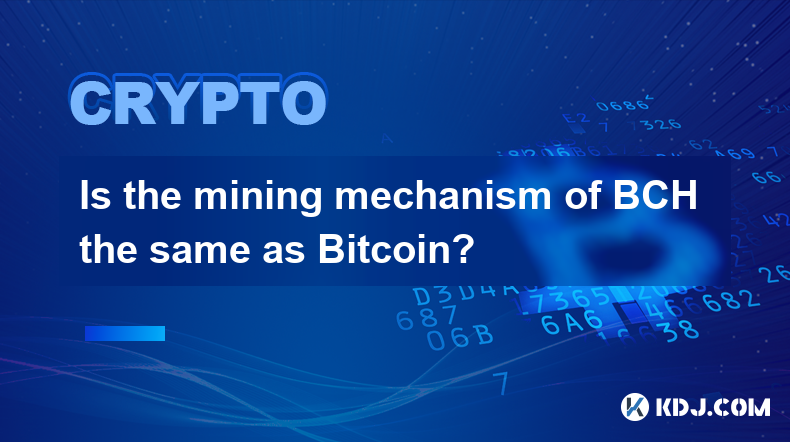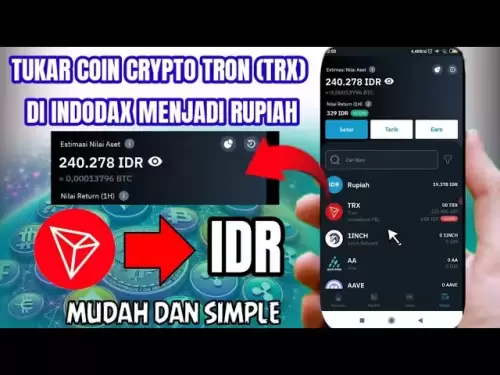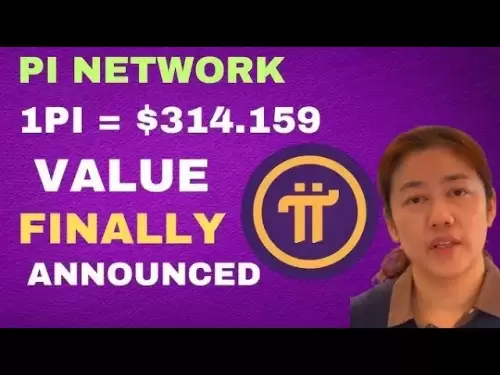-
 Bitcoin
Bitcoin $107,397.3430
-0.20% -
 Ethereum
Ethereum $2,467.5633
1.33% -
 Tether USDt
Tether USDt $1.0002
0.01% -
 XRP
XRP $2.1994
0.71% -
 BNB
BNB $655.8723
1.07% -
 Solana
Solana $157.3780
4.63% -
 USDC
USDC $1.0000
0.02% -
 TRON
TRON $0.2792
1.23% -
 Dogecoin
Dogecoin $0.1645
0.50% -
 Cardano
Cardano $0.5666
1.83% -
 Hyperliquid
Hyperliquid $39.8730
3.91% -
 Bitcoin Cash
Bitcoin Cash $514.7673
5.02% -
 Sui
Sui $2.7969
-0.51% -
 Chainlink
Chainlink $13.2880
0.07% -
 UNUS SED LEO
UNUS SED LEO $9.1148
-0.60% -
 Avalanche
Avalanche $17.9247
0.34% -
 Stellar
Stellar $0.2351
-0.98% -
 Toncoin
Toncoin $2.9456
2.69% -
 Shiba Inu
Shiba Inu $0.0...01144
-0.74% -
 Litecoin
Litecoin $85.9064
-0.62% -
 Hedera
Hedera $0.1495
1.47% -
 Monero
Monero $319.0339
3.82% -
 Polkadot
Polkadot $3.3940
-0.40% -
 Dai
Dai $1.0000
0.01% -
 Ethena USDe
Ethena USDe $1.0003
0.00% -
 Bitget Token
Bitget Token $4.5223
-1.95% -
 Uniswap
Uniswap $7.1384
-0.02% -
 Aave
Aave $272.7534
0.72% -
 Pepe
Pepe $0.0...09836
2.57% -
 Pi
Pi $0.5107
-2.06%
Is the mining mechanism of BCH the same as Bitcoin?
Bitcoin Cash (BCH) and Bitcoin (BTC) mining, though both using Proof-of-Work, differ significantly due to varying block sizes and difficulty adjustments, impacting mining profitability, hardware needs, and energy consumption.
Mar 13, 2025 at 05:40 pm

Key Points:
- Bitcoin Cash (BCH) and Bitcoin (BTC) share a common ancestor but diverge significantly in their mining mechanisms, primarily due to differing block size limits.
- BCH utilizes a simpler, less computationally intensive mining algorithm compared to BTC, leading to variations in mining profitability and hardware requirements.
- While both use Proof-of-Work (PoW), the differing block sizes influence the frequency of block creation and the overall network efficiency.
- The choice of mining hardware is significantly impacted by the algorithm used and the block size, affecting both profitability and energy consumption.
- Differences in the mining difficulty adjustment mechanisms also contribute to variations in the mining experience between BCH and BTC.
Is the mining mechanism of BCH the same as Bitcoin?
No, while Bitcoin Cash (BCH) originated from Bitcoin (BTC), its mining mechanism differs in several key aspects. Both use a Proof-of-Work (PoW) consensus mechanism, requiring miners to solve complex cryptographic problems to validate transactions and add new blocks to the blockchain. However, the specifics of this process vary considerably.
The most significant difference lies in the block size limit. Bitcoin has a significantly smaller block size limit than BCH. This limitation directly impacts the transaction throughput and, consequently, the mining rewards and efficiency. BCH's larger block size allows for more transactions to be included in each block, potentially leading to faster confirmation times and lower transaction fees. This difference also affects the computational demands on miners.
Bitcoin uses the SHA-256 hashing algorithm, a computationally intensive process requiring specialized hardware like ASICs (Application-Specific Integrated Circuits) for efficient mining. BCH also uses SHA-256, but the larger block size means miners can potentially earn more rewards per unit of computational power. This difference attracts different types of miners and impacts the overall network security.
The difficulty adjustment mechanisms, which regulate the rate at which new blocks are added to the blockchain, also differ slightly between BCH and BTC. These differences ensure the target block generation time remains relatively consistent despite fluctuations in mining hash rate. However, the specific algorithms and parameters used differ, leading to variations in how quickly the network adapts to changes in mining power.
The differing block sizes and the consequent changes in transaction volume directly affect the profitability of mining each cryptocurrency. Miners need to consider the cost of electricity, hardware, and maintenance against the potential rewards received for successfully mining a block. The rewards are distributed among the miners who successfully solve the cryptographic problem first, encouraging competition and securing the network.
The choice of mining hardware is directly influenced by the algorithm and the profitability associated with mining each coin. While both BTC and BCH use SHA-256, the larger block size and potential for higher rewards in BCH might make it more attractive for certain types of mining operations. This can lead to different levels of centralization and overall network security. Efficient mining requires significant upfront investment in specialized hardware and ongoing operational costs.
The overall energy consumption associated with mining both cryptocurrencies is also impacted by their respective mechanisms. The larger block size of BCH, while potentially offering faster transaction speeds, might also lead to increased energy consumption if the overall hash rate of the network increases significantly. The energy efficiency of the hardware used also plays a vital role in the environmental impact of the mining process.
Common Questions and Answers:
Q: Can I mine both BTC and BCH with the same hardware?
A: Yes, you can use the same type of ASIC miners (designed for SHA-256) for both BTC and BCH mining. However, profitability depends on factors like hash rate, electricity costs, and the current difficulty of each network. Switching between them requires reconfiguring your mining software.
Q: Which cryptocurrency is more profitable to mine, BCH or BTC?
A: Profitability depends on several factors: the current difficulty of each network, the price of each cryptocurrency, the cost of electricity, and the hash rate of your mining hardware. There is no consistent answer; it changes dynamically.
Q: Is BCH mining more environmentally friendly than BTC mining?
A: The environmental impact depends on several factors, including the efficiency of the mining hardware, the electricity source used, and the overall hash rate of the network. Currently, there's no definitive answer on which is inherently more environmentally friendly. Both rely on PoW, which is inherently energy-intensive.
Q: What are the key differences in the security of the BCH and BTC networks?
A: Both rely on the Proof-of-Work system, so the security depends on the total hash rate. A higher hash rate generally equates to a more secure network. The difference in block size doesn't directly affect the fundamental security model, but it may influence the ability to withstand certain types of attacks.
Q: How do the transaction fees compare between BCH and BTC mining?
A: BCH generally has lower transaction fees than BTC due to its larger block size. However, this can fluctuate depending on network congestion. The larger block size allows more transactions to be processed per block, potentially reducing the cost per transaction.
Disclaimer:info@kdj.com
The information provided is not trading advice. kdj.com does not assume any responsibility for any investments made based on the information provided in this article. Cryptocurrencies are highly volatile and it is highly recommended that you invest with caution after thorough research!
If you believe that the content used on this website infringes your copyright, please contact us immediately (info@kdj.com) and we will delete it promptly.
- Unlock Crypto Riches: Mining Platforms & Starter Bonuses - Your Gateway to Digital Gold!
- 2025-06-30 22:30:11
- Dogecoin, Cloud Mining, and Risk Alerts: Navigating the Meme Minefield
- 2025-06-30 22:30:11
- Ric Edelman's Bold Crypto Allocation: A Financial Advisor's Perspective
- 2025-06-30 22:50:12
- Bitcoin Layer-2 Presale Heats Up: Is HYPER the Next Big Thing?
- 2025-06-30 22:50:12
- Bitcoin's Bull Run: Network Activity Tells a Different Story
- 2025-06-30 22:55:12
- SpacePay, Altcoins & Investing in 2025: What's the Buzz?
- 2025-06-30 23:10:12
Related knowledge

How to customize USDT TRC20 mining fees? Flexible adjustment tutorial
Jun 13,2025 at 01:42am
Understanding USDT TRC20 Mining FeesMining fees on the TRON (TRC20) network are essential for processing transactions. Unlike Bitcoin or Ethereum, where miners directly validate transactions, TRON uses a delegated proof-of-stake (DPoS) mechanism. However, users still need to pay bandwidth and energy fees, which are collectively referred to as 'mining fe...

USDT TRC20 transaction is stuck? Solution summary
Jun 14,2025 at 11:15pm
Understanding USDT TRC20 TransactionsWhen users mention that a USDT TRC20 transaction is stuck, they typically refer to a situation where the transfer of Tether (USDT) on the TRON blockchain has not been confirmed for an extended period. This issue may arise due to various reasons such as network congestion, insufficient transaction fees, or wallet-rela...

How to cancel USDT TRC20 unconfirmed transactions? Operation guide
Jun 13,2025 at 11:01pm
Understanding USDT TRC20 Unconfirmed TransactionsWhen dealing with USDT TRC20 transactions, it’s crucial to understand what an unconfirmed transaction means. An unconfirmed transaction is one that has been broadcasted to the blockchain network but hasn’t yet been included in a block. This typically occurs due to low transaction fees or network congestio...

How to check USDT TRC20 balance? Introduction to multiple query methods
Jun 21,2025 at 02:42am
Understanding USDT TRC20 and Its ImportanceUSDT (Tether) is one of the most widely used stablecoins in the cryptocurrency market. It exists on multiple blockchain networks, including TRC20, which operates on the Tron (TRX) network. Checking your USDT TRC20 balance accurately is crucial for users who hold or transact with this asset. Whether you're sendi...

What to do if USDT TRC20 transfers are congested? Speed up trading skills
Jun 13,2025 at 09:56am
Understanding USDT TRC20 Transfer CongestionWhen transferring USDT TRC20, users may occasionally experience delays or congestion. This typically occurs due to network overload on the TRON blockchain, which hosts the TRC20 version of Tether. Unlike the ERC20 variant (which runs on Ethereum), TRC20 transactions are generally faster and cheaper, but during...

The relationship between USDT TRC20 and TRON chain: technical background analysis
Jun 12,2025 at 01:28pm
What is USDT TRC20?USDT TRC20 refers to the Tether (USDT) token issued on the TRON blockchain using the TRC-20 standard. Unlike the more commonly known ERC-20 version of USDT (which runs on Ethereum), the TRC-20 variant leverages the TRON network's infrastructure for faster and cheaper transactions. The emergence of this version came as part of Tether’s...

How to customize USDT TRC20 mining fees? Flexible adjustment tutorial
Jun 13,2025 at 01:42am
Understanding USDT TRC20 Mining FeesMining fees on the TRON (TRC20) network are essential for processing transactions. Unlike Bitcoin or Ethereum, where miners directly validate transactions, TRON uses a delegated proof-of-stake (DPoS) mechanism. However, users still need to pay bandwidth and energy fees, which are collectively referred to as 'mining fe...

USDT TRC20 transaction is stuck? Solution summary
Jun 14,2025 at 11:15pm
Understanding USDT TRC20 TransactionsWhen users mention that a USDT TRC20 transaction is stuck, they typically refer to a situation where the transfer of Tether (USDT) on the TRON blockchain has not been confirmed for an extended period. This issue may arise due to various reasons such as network congestion, insufficient transaction fees, or wallet-rela...

How to cancel USDT TRC20 unconfirmed transactions? Operation guide
Jun 13,2025 at 11:01pm
Understanding USDT TRC20 Unconfirmed TransactionsWhen dealing with USDT TRC20 transactions, it’s crucial to understand what an unconfirmed transaction means. An unconfirmed transaction is one that has been broadcasted to the blockchain network but hasn’t yet been included in a block. This typically occurs due to low transaction fees or network congestio...

How to check USDT TRC20 balance? Introduction to multiple query methods
Jun 21,2025 at 02:42am
Understanding USDT TRC20 and Its ImportanceUSDT (Tether) is one of the most widely used stablecoins in the cryptocurrency market. It exists on multiple blockchain networks, including TRC20, which operates on the Tron (TRX) network. Checking your USDT TRC20 balance accurately is crucial for users who hold or transact with this asset. Whether you're sendi...

What to do if USDT TRC20 transfers are congested? Speed up trading skills
Jun 13,2025 at 09:56am
Understanding USDT TRC20 Transfer CongestionWhen transferring USDT TRC20, users may occasionally experience delays or congestion. This typically occurs due to network overload on the TRON blockchain, which hosts the TRC20 version of Tether. Unlike the ERC20 variant (which runs on Ethereum), TRC20 transactions are generally faster and cheaper, but during...

The relationship between USDT TRC20 and TRON chain: technical background analysis
Jun 12,2025 at 01:28pm
What is USDT TRC20?USDT TRC20 refers to the Tether (USDT) token issued on the TRON blockchain using the TRC-20 standard. Unlike the more commonly known ERC-20 version of USDT (which runs on Ethereum), the TRC-20 variant leverages the TRON network's infrastructure for faster and cheaper transactions. The emergence of this version came as part of Tether’s...
See all articles

























































































